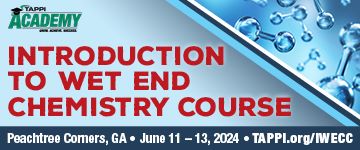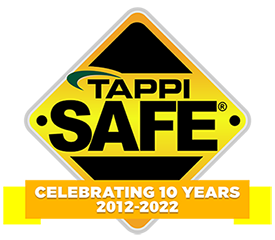 Search
Search
Use the search bar or filters below to find any TAPPI product or publication.
Filters
Content Type
Publications
Level of Knowledge
Committees
Collections
Journal articles

Magazine articles

The Shendye-Fleming OBA Index for paper and paperboard, TAPPI Journal March 2022
ABSTRACT: We are proposing a new one-dimensional scale to calculate the effects of optical brightening agents (OBA) on the bluish appearance of paper. This index is separate from brightness and whiteness indices.In the paper industry, one-dimensional scales are widely used for determining optical properties of paper and paperboard. Whiteness, tint, brightness, yellowness, and opacity are the most common optical properties of paper and paperboard. Most of the papers have a blue cast generated by addition of OBA or blue dyes. This blue cast is given because of the human perception that bluer is whiter, up to a certain limit. To quantify this effect, it is necessary to determine how much blue cast paper and paperboard have. As the printing industry follows the ISO 3664 Standard for viewing, which has a D50 light source, this also plays a very important role in showing a blue cast. Color perception is based on light source and light reflected from an object. The ultraviolet (UV) component in D50 interacts with OBA to provide a reflection in the blue region of the visible spectrum. Use of a UV blocking filter results in measurements without the effect of emission in the blue region. This difference is used in determining the OBA effect in the visible range of the paper. This equation is known as the Shendye-Fleming OBA Index.
Journal articles

Magazine articles

Editorial: Unlock the gates! TAPPI Journal moves to fully Open Access research for all, TAPPI Journal March 2022
TAPPI and the TAPPI Journal (TJ) Editorial board and staff are pleased to announce that TJ’s content is now immediately open access (OA), with no embargoes. In 2020, the journal had adopted a hybrid OA model wherein its peer-reviewed research was free to TAPPI members for one year and then became free to all on the one-year anniversary of a research paper’s publishing date. Now, research is immediately accessible to all, increasing visibility and engagement for authors and providing an unobstructed view for researchers, students, and other interested parties.
Journal articles

Magazine articles

Editorial: Looking forward, looking back, TAPPI Journal January 2022
ABSTRACT: Much like 2020, 2021 was another year of remarkable highs and lows delivered by the COVID-19 pandemic. Vaccines, variants, and infection surges altered the way we behaved personally and professionally last year. As we move into 2022, we are now grappling with health and business concerns from the omicron variant that has overwhelmed hospitals in some areas and contributed to a global supply chain crisis. The ability to adjust has once again become a key skill in adapting to our shifting “new normal.”
Journal articles

Magazine articles

Rethinking the paper cup — beginning with extrusion process optimization for compostability and recyclability, TAPPI Journal June 2021
ABSTRACT: More than 50 billion disposable paper cups used for cold and hot beverages are sold within the United States each year. Most of the cups are coated with a thin layer of plastic — low density polyethylene (LDPE) — to prevent leaking and staining. While the paper in these cups is both recyclable and compostable, the LDPE coat-ing is neither. In recycling a paper cup, the paper is separated from the plastic lining. The paper is sent to be recycled and the plastic lining is typically sent to landfill. In an industrial composting environment, the paper and lining can be composted together if the lining is made from compostable materials. Coating paper cups with a compostable performance material uniquely allows for used cups to be processed by either recycling or composting, thus creating multiple pathways for these products to flow through a circular economy.A segment of the paper converting industry frequently uses an extrusion grade of polylactic acid (PLA) for zero-waste venues and for municipalities with ordinances for local composting and food service items. The results among these early adopters reveal process inefficiencies that elevate manufacturing costs while increasing scrap and generally lowering output when using PLA for extrusion coating. NatureWorks and Sung An Machinery (SAM) North America researched the extrusion coating process utilizing the incumbent polymer (LDPE) and PLA. The trademarked Ingeo 1102 is a new, compostable, and bio-based PLA grade that is specifically designed for the extrusion coating process. The research team identified the optimum process parameters for new, dedicated PLA extrusion coating lines. The team also identified changes to existing LDPE extrusion lines that processors can make today to improve output.The key finding is that LDPE and PLA are significantly different polymers and that processing them on the same equipment without modification of systems and/or setpoints can be the root cause of inefficiencies. These polymers each have unique processing requirements with inverse responses. Fine tuning existing systems may improve over-all output for the biopolymer without capital investment, and this study showed an increase in line speed of 130% by making these adjustments. However, the researchers found that highest productivity can be achieved by specifying new systems for PLA. A line speed increase to more than 180% and a reduction in coat weight to 8.6 µm (10.6 g/m2 or 6.5 lb/3000 ft2) was achieved in this study. These results show that Ingeo 1102 could be used as a paper coating beyond cups.
Journal articles

Magazine articles

Probing the molecular weights of sweetgum and pine kraft lignin fractions, TAPPI Journal June 2021
ABSTRACT: The present investigation undertook a systematic investigation of the molecular weight (MW) of kraft lignins throughout the pulping process to establish a correlation between MW and lignin recovery at different extents of the kraft pulping process. The evaluation of MW is crucial for lignin characterization and utilization, since it is known to influence the kinetics of lignin reactivity and its resultant physico-chemical properties. Sweetgum and pine lignins precipitated from black liquor at different pHs (9.5 and 2.5) and different extents of kraft pulping (30•150 min) were the subject of this effort. Gel permeation chromatography (GPC) was used to determine the number average molecular weight (Mn), mass average molecular weight (Mw), and polydispersity of the lignin samples. It was shown that the MW of lignins from both feedstocks follow gel degradation theory; that is, at the onset of the kraft pulping process low molecular weight-lignins were obtained, and as pulping progressed, the molecular weight peaked and subsequently decreased. An important finding was that acetobromination was shown to be a more effective derivatization technique for carbohydrates containing lignins than acetylation, the technique typically used for derivatization of lignin.
Journal articles

Magazine articles

Effectiveness of masks in the suppression of COVID-19 cases during the ongoing pandemic in India, TAPPI Journal October 2022
ABSTRACT: Perhaps the worst predicament faced by humanity in the twenty-first century is the COVID-19 pandemic, which is caused by the SARS-CoV-2 virus. Most parts of the world, including India, went into lockdowns for some period because of the massive increase in cases throughout 2020. Face masks became an important counter-measure for protecting the populace, health professionals, and medics, particularly during the period prior to the mass availability of vaccines. This study intends to evaluate the effectiveness of face masks in limiting the spread of the virus. The data for the number of COVID-19 cases was analyzed from January 1, 2022 to May 31, 2022, using Python programming. This timeframe involved face mask mandates and no mask requirement, and hence was considered to be ideal for analyzing the usefulness of face masks. A decline in cases during the mandate was observed, while the opposite occurred without the mandate. The outcome of the research showed that face masks are effective additional measures against the spread of SARS-CoV-2. This study elevates the value of personal protective equipment (PPE), such as face masks, made with nonwovens and other fabrics, as lifesavers in the case of airborne diseases such as COVID-19 and other pulmonary disorders.
Journal articles

Magazine articles

Furnishing autohydrolyzed poplar weakly alkaline P-RC APMP to make lightweight coated base paper, TAPPI Journal February 2022
ABSTRACT: This work investigated the effects of autohydrolysis pretreatment severity on poplar (Populus tomentosa Carr.) woodchips used to make a type of high-yield pulp (HYP) known as preconditioning followed by refiner chemical treatment, alkaline peroxide mechanical pulp (P-RC APMP). It also investigated the ratios for partially replacing sodium hydroxide (NaOH) with magnesium oxide (MgO) in the high-consistency (HC) retention stage of the P-RC APMP process on the obtained HYP’s properties. The results show that the pretreatment severity of autohydrolysis at combined hydrolysis factor (CHF) = 10.77 and the 50 wt% ratio for partially substituting NaOH with MgO were the optimum conditions for making light-weight coated (LWC) base paper. Compared to the conventional P-RC APMP, the optimized P-RC APMP had similar bulk and higher tensile, burst, and tear indices, as well as opacity, but a slightly lower ISO brightness. When the optimized P-RC APMP and commercial softwood bleached sulfate pulp (SBKP) were blended to make LWC base paper, the most favorable pulp furnish was comprised of 50% optimized P-RC APMP and 50% commercial SBKP. The obtained LWC base paper handsheet had better bulk, and its other properties could also meet the require-ments of LWC base paper.
Journal articles

Magazine articles

The Effect of Component Removal Upon the Porous Structure of the Cell Wall of Wood. II. Swelling in Water and the Fiber Saturation Point, TAPPI Journal May 2022
ABSTRACT: The word "swelling" applied to an assemblage of fibers such as wood or wood pul p is very vague.
Magazine articles

Views from the top: ceos offer global perspectives on the pulp and paper industries, TAPPI JOURNAL, August 1999, Vol. 82(8)
Views from the top: ceos offer global perspectives on the pulp and paper industries, TAPPI JOURNAL, August 1999, Vol. 82(8)
Journal articles

Magazine articles

Editorial: Agility and adaptation in a dynamic business world, TAPPI Journal January 2021
ABSTRACT: Being agile and adaptive in this current business world is both necessary and beneficial. Throughout last year, we all continued to both directly and indirectly experience the dynamic world where we live. As we wll know, in early 2020 the pandemic gained momentum and has fundamentally altered our daily lives, both personally in how we live and professionally in how we work.






